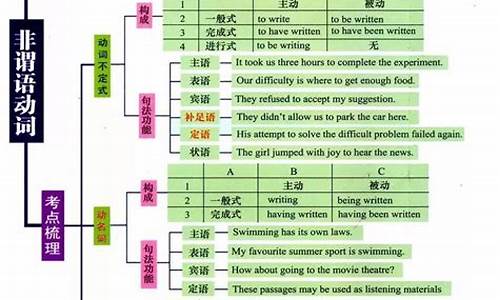您现在的位置是: 首页 > 教育新闻 教育新闻
高考谓语总结,高考谓语动词试题及答案
tamoadmin 2024-06-18 人已围观
简介1.高考单选题,如何判断非谓语作状语这个考点2.高考的语法题中如何区分位于动词和非谓语动词3.高考常考成语解释用法及例句有哪些?4.高考英语语法:高中英语语法-非谓语动词15.英语非谓语动词知识点详解系动词系动词又称联系动词,作为系动词,它本身有词义,但不能单独用作谓语,后边必须跟表语(也称补语),构成系表结构说明主语的状况、性质、特征等情况。有些系动词又是实义动词,该动词表达实义时,有词义,可单
1.高考单选题,如何判断非谓语作状语这个考点
2.高考的语法题中如何区分位于动词和非谓语动词
3.高考常考成语解释用法及例句有哪些?
4.高考英语语法:高中英语语法-非谓语动词1
5.英语非谓语动词知识点详解

系动词
系动词又称联系动词,作为系动词,它本身有词义,但不能单独用作谓语,后边必须跟表语(也称补语),构成系表结构说明主语的状况、性质、特征等情况。
有些系动词又是实义动词,该动词表达实义时,有词义,可单独作谓语,例如:
He fell illyesterday.
(fall是系动词,后跟补足语,说明主语情况
He fell off theladder.
(fall是实义动词,单独作谓语。)
1)状态系动词
用来表示主语状态,只有be一词,例如:
He is a teacher.
(is与补足语一起说明主语的身份。)
2)持续系动词
用来表示主语继续或保持一种状况或态度,主要有keep, rest, remain, stay, lie, stand, 例如:
He always keptsilent at meeting.
This matter restsa mystery.
3)表像系动词
用来表示"看起来像"这一概念,主要有seem, appear, look, 例如:
He looks tired.
He seems (to be)very sad.
4)感官系动词
主要有feel, smell, sound, taste, 例如:
This kind of clothfeels very soft.
This flower smellsvery sweet.
5)变化系动词
表示主语变成什么样,有become, grow, turn, fall, get, go, come,run
He became madafter that.
She grew richwithin a short time.
6)终止系动词
表示主语已终止动作,主要有prove, trun out, 表达"证实","变成"之意,例如:
The rumor provedfalse.
The search proveddifficult. 搜查证实很难。
His plan turnedout a success. (turn out表终止性结果)
I、常见系动词错误及其成因:
(1)漏掉系动词
I afraid he won'tcome tomorrow .
( 2 )误用系动词
His hair changedgrey .(混淆了change 与turn,grow)
I.系动词分类:
一、根据系动词后所跟结构,分为两大类:完全系动词(其后只能跟表语的动词,如be)和半系动词(其后既可跟表语作系动词用法,也可跟宾语或状语作实义动词用,如look)
He looked sad atthe news.
(“看起来”,系动词用法)
He looks at aclever boy.
(“看着”,实义动词用法)
在英语中,某一动词是多义词,既有实义动词用法,又有系动词用法。常见的有:
listen, look ,touch ,hear,see ,sound ,feel, taste ,remain ,keep,stay, turn,become
二、根据系动词的意义,分为四类:
A.五大感官系动词 B.状态系动词
C.动态系动词 D.双谓语系动词
A.五大感官系动词,描述一种感官性质。由实义感官动词变化而来,都是半系动词
1.look“看起来像是”,后接adj.、n.、分词、介词短语、不定式等。
The girl bit herlips and looked thoughtful.
2.smell“闻起来”,后接adj.,分词。
The flowers smellsweet.
3.sound“听起来”,后接adj.,分词。
The music soundssweet.
4.taste“尝起来”,后接adj.,分词。
The apples tastevery good.
5.feel①“摸起来,给……感觉”;②“觉得”,后接adj
The silk feelsvery soft.
You will feelbetter after a night’s sleep.
B.状态系动词:
1.be,“是”,完全系动词。
I am a student.
2.seem,“似乎,好像”,完全系动词。
They seem quitehappy.
3.appear,“显得,看起来好像”,半系动词。
He appeared tiredand sleepy.
It appeared(tobe)a true story.
Now it appears tome that he may play an important part in settling the problem. (在我看来)
4.keep, “保持……的状态”,半系动词,后接adj或介词短语。
You’d better go to bed and keep warm.
5.remain,“仍是”,半系动词。
I remained silent.
6.stay“保持(某种状态)”,半系动词,后接adj.、过去分词。
The window stayedopen all the night.
7.prove “证明是”,半系动词,后接adj.,n.
The treatmentproved to be successful.
C.动态系动词:都属于半系动词,描述状态变化过程。
1.get“变成,变得……起来”,后可接形容词、分词、介词短语。
The days aregetting longer and longer.
The train didn’t get going again.
It’s nothing to get excited about.
My watch gets outof order.
2.fall“进入(某种状态),成为”,后常接以下形容词:
asleep, silent,ill, sick
The old man,unable to express himself, fell silent.
My father fell illand died.
3.grow“渐渐变得……起来,长得”
You will grow usedto it.
It’s growing warm.
4.turn“转变成(新的与原来完全不同的色彩或性质),变质(色)”。
Maple trees turnred in autumn.
It was cloudy thismorning, but fortunately it has turned fine.
He has turnedwriter.
(注意:此时writer之前无冠词a.)
5.go,“变成(某种坏的状态)”
The telephone hasgone dead.
The material hasgone a funny colour. (奇怪)
go之后常接的adj. 还有:bad, blind, wild, wrong, sour, hard, hungry,mad, red, with, anger, white, pale, blue, grey
6.become“变成,成为(好坏均可的情况)”
He became angrywith me.
It became dark.
They became goodfriends.
I becameinterested in drawing.
7.come,“变成为(已知的状态),证实为”,后接形容词或前缀un-的过去分词作表语,表示状态或情况的变化。
His wish to becomea pilot has come true.
If you look intothe matter, everything will come clear.
My shoelaces havecome undone.
后面常接的形容词还有:apart, dear(昂贵),natural,open, untied(松开)。
8.run,“变成”,后接adj.
The well has rundry.
The price ranhigh.
9.make,“达到某种状态[后接形容词],如sure, certain, merry, bold, free
We must makecertain of facts.
我们一定要弄清事实。
The Children makefree with the apples.
孩子们随便吃苹果。
D.双谓语系动词
此类系动词既有系动词的功能,后接表语,又保留原实义动词本身的含义。例如:
The run rose red. 太阳升起红艳艳。
She stopped andstood quite still.
The book lay openon the table.
The snow lay thickon the ground.
He marriedyoung.
The window blew open.
III.系动词用法应注意的八个问题
1.系动词的进行时态应分情况讨论
一般,状态系动词无进行时态,而动态系动词有进行时态。但在某些情况下,状态系动词也有进行时态,表示两个用途:
(1)表示一种短暂的、反常的状态。如:
He is being kind.
他装出和蔼可亲的样子(一时而不能持久的性质)
(2)表示一种探询口气,使语言客气、生动、亲切。例如:
I hope you arekeeping well.
(语气委婉)
Are you feelingany better?
(语气亲切)
试比较:
Your hand feelscold.
你的手摸起来冰凉(无意识的静态性质)
不可以说:
Your hand isfeeling cold.(×)
The doctor isfeeling her pulse.
医生正在给她把脉(有意识的动态动作)
The soup tastesgood.
这汤的味道不错(静态性质,无进行时)
The cook istasting the soup.厨师在尝汤的味道。(动态动作,有进行时)
总之,系动词有无进行时态应随系动词的意义或其语境变化而变化。在概述某一动词的进行时态时,不能笼统地说feel,smell无进行时,应指出其意义及其语用环境。以smell为例
①smell作“嗅觉”的能力时,虽是实义动词,但指的是一种性质的存在状态不能用于进行时态,常与can, could, be able to连用。
The camels cansmell the water a mile off.
骆驼能嗅出一英里外有水。
②指“嗅、闻”的动作时,实义动词,可用于进行时态。
The girl issmelling the flower.
③smell指“含有……气味”,“发出……气味”等事物性质时,半系动词,无进行时态。
The dinner smellsgood.
2.系动词的时态与形容词的比较级连用的问题
某些含有变化意义的动态系动词如get, become, grow, turn等的进行时态可与形容词的比较级连用,表示渐进过程,其意思是“越来越……”。
He is growingtaller and taller.
Our life isgetting better and better.
The things aregetting worse.
3.所有半系动词的被动语态要分情况讨论
某动词在作系动词用时,无被动语态,而作实义动词用时,才有被动语态
不能说: The apple is tasted good.
(因为taste此时是系动词,“尝起来”之意,指的是苹果的性质,无被动语态)
但可以说: The apple is tasted by me.
(taste此时指“尝一尝”这一动作,有被动语态)
因此要注意半系动词在具体的语言环境中到底是系动词用法还是实义动词用法
4.瞬间动态系动词能否与时间段连用的问题
某些表示瞬间意义的系动词不能与“for+时间段,since+时间点,how long until+时间,by + 时间,so far”直接连用
①不能说:
He has become ateacher for 2 years.
应改为:
He has been ateacher for 2 years.
②不能说:He has turned writer since 3 years ago.
应改为:He has been a write since 3 years ago.
或It is two years since he turned writer.
③不能说:He got angry until his child came backhome.
应改为:He didn’t getangry until his child came back home.
5.系动词能接几种表语(从句)
系动词除了接adj.\n.\介词短语,某些adv.以外,还可接以下几种表语形式:
①能接as if/as though表语从句的系动词有:look,smell,sound,feel;appear(显得),seem(似乎)
It looks as if weare going to have snow.
He looked as if hehad just stepped out of my book of fairy tales.
It seems as if it werespring already.
②可用于“It+系动词+that从句”结构的有:seem, appear, 不可用be, look
It seemed that hehad made some serious mistakes in his work.
It appeared thathe was talking to himself.
③能用不定式作表语的系动词有:be, seem, get, look, appear, prove, grow.
Her job is to lookafter the children.
He looks to be ayoung girl of twenty.
④能与there连用的系动词有:be,appear, seem.
There appeared tobe only one room.
There seems(tobe)no need to go.
6.能用两种否定形式的系动词有两个:seem, appear.
It doesn’t seem that we can get our money back.
= It seems that wecan’t get our money back.
He seems not to beher father.
= He doesn’t seem to be her father.
The baby doesn’t appear to be awake.
= The baby appearsnot to be awake.
7、几组易混系动词的区别
系动词的区别主要从两个方面作比较,一是其意义,二是其结构。
1)get, become, go, turn, grow“变成”
get:“变得”口语。后接形容词、现在分词、过去分词、介词短语、不定式作表语,但不能与名词直接连用。
become:“变成,成为(好坏情况均可)。”后接形容词、名词、过去分词作表语,不能与不定式连用。
go:“变成(某种由好到坏的情况)”,后接形容词、过去分词、名词作表语。
Turn:“转变成”强调与原来不同的、新的变化,如变质、变色等。后接形容词、不带冠词的名词作表语,后不接不定式。
grow:“逐渐变得……”,强调其变化过程。后接形容词、分词、不定式,不可直接跟名词。
2)look, seem, appear“好像”
三者作系动词时在意义上的区别:
look:“好像,看起来”,一般用于非正式场合,侧重指从本身外表特征上由视觉得到的印象。
seem :“似乎,好像”,指说话人内心的估计与判断,有一定依据,接近于实际情况。
appear:“显得,好像”,常用于正式文体中,指某事物或人给他人的表面印象,有时含有实质上并非如此之意。
He looks like hisfather. (指其长相看起来相像)
He seems like hisfather. (指说话人从个性方面得到的判断)
He appears likehis father.(指他的外貌、衣着给他人的印象)
3)keep, remain, stay“保持……状态”
①keep作系动词时,“保持……状态”,后接adj.或介词短语:alive,awake,cheerful,silent,dry,well,fit,fine,close,clean,happy
Have you kept wellall these years?
I hope it willkeep fine.
In order to keepfit, all students go in for sports.
We’d better keep in touch.
②remain,系动词“仍然存在……状态”,后接adj.、过去分词、名词或介词短语,强调某种状态前后无变化。
The door remainedclosed.
门仍然关着。
Your room remainslike this.
你的房间依旧是这样子。
③stay,作系动词用时“保持……状态”,后接形容词、分词。
That fellow stayedsingle.
那个小伙子仍保持单身。
It’s easy to stay hidden.
躲起来很容易。
后常接的形容词有:calm, clean, fresh, healthy, young, open,awake, warm, fine, 常可与keep互换。如:
Stay/keepcalm(clean, fine, healthy, awake等)
①What you have said_______.
A.is soundedinteresting
B.soundsinteresting
C.soundinterested
D.listensinterested
②The class begins. Please keep________.
A.silent B.silence
C.the silence D.silently
③Look! Several people in the crowdseemed_______.
A.to be fighting B.to havefought
C.being fought D.havingfought
④How _____the song she sings sounds! I havenever ______a better voice.
A.beautifully, sounded
B.beautiful, sounded
C.sweet, listened to
D.sweet, heard
⑤Her feeling about the marriage ______ratherstrange.
A.is looked B.is seemed
C.seems D.isappeared
⑥John _____driver since two months ago.
A.became a B.has becomea
C.has turned D.has been a
⑦The ice_____ thick on the river.
A.is lain
B.lay
C.laid
D.lie
高考单选题,如何判断非谓语作状语这个考点
考动词时,大体分为谓语动词和非谓语动词。
谓语动词要考虑时态和语态。考时态时看句子时态的标志性词,例如:so far与现在完成时连用,或者有时得根据句子的语意来判断。考语态时,考虑主动语态和被动语态。
非谓语动词要找到该动词的逻辑主语,看该动词与逻辑主语是主谓关系还是动宾关系来进行选择。有时填不定式表将来或目的。
动词还考词性转化,要熟悉相关的形容词,副词和名词
高考的语法题中如何区分位于动词和非谓语动词
判断非谓语作状语这个考点方法:
1.非谓语动词就是不能在句子中做谓语。英语的非谓语动词有:动词不定式(to do)、现在分词(doing)、过去分词 (done)、动名词(doing)。
2.句子的成分一般由主语、谓语、表语、宾语、定语,状语等构成。谓语一般要有动词担任,非谓语动词是不能独立担任谓语的。 但可以担任句子的其他成分,在这里老师给你简要叙述如下:
(1).动词不定式可担任主语,宾语,表语,宾补,定语,状语等。
(2.)动名词可担任主语,表语,宾语,定语等。
(3).现在分词和过去分词可担任定语,表语,宾补,状语等。
例如: He came here to ask for his bike.他来这里要他的自行车。
分析句子成分: he(代词)做 主语, came(动词)做 谓语, here(副词)做状语,to ask for hisbike(动词不等式短语)做目的状语。
高考常考成语解释用法及例句有哪些?
这么说吧,动词的全称就是谓语动词。你问的实际上就是谓语动词和非谓语动词的区别。一个句子里只能出现一个动词,如果有两个,咱们就把其中一个变成非谓语,方法是加ed 或ing.被动是ed.主动是ing
高考英语语法:高中英语语法-非谓语动词1
天伦之乐(tiān lún zhī lè)
解释:泛指家庭的乐趣。
用法:偏正式,作宾语,含褒义。
例句:只要走进他们的新居,就会感到,这是一个舒适的休憩处所,更是享受天伦之乐的家园。
津津有味(jīn jīn yǒu wèi)
解释:指吃得很有味道或谈得很有兴趣。
用法:偏正式,作谓语,宾语,含褒义。 ?
例句:这个故事被老师讲得饶有风趣,我们也听得津津有味。
锐不可当(ruì bù kě dāng)
解释:形容勇往直前的气势,不可抵挡。
用法:主谓式,作谓语,宾语,定语,状语,含褒义。
例句:想当年他所带领的军队以锐不可当之势,横扫大江南北。
忍俊不禁(rěn jùn bù jīn)
解释:指忍不住要发笑。
用法:偏正式,作谓语,状语。
例句:读完这个寓言故事,我忍俊不禁。它太有意思了。
耿耿于怀(gěng gěng yú huái)
解释:不能忘怀,牵萦于心。
用法:偏正式,作谓语,定语,词性为贬义 ?。 ?
例句:国民党的阴谋被揭露后,他们对这个爱国人士耿耿于怀。
引人入胜(yǐn rén rù shèng)
解释:引人进入佳境。现多用来指风景或文艺作品特别吸引人。
用法: 兼语式,作谓语,定语,状语,宾语,含褒义。 ?
例句:?他的表演应该说是引人入胜的,但略嫌有点阳春白雪的感觉,还没有达到雅俗共赏的水平。
目不暇接(mù bù xiá jiē)
解释:指东西多,眼睛都看不过来。?
用法:主谓式,作谓语,定语,状语,用于“令人”后。?
例句:车窗外飞掠的景物令他目不暇接。
自命不凡(zì mìng bù fán)
解释:自以为不平凡,比别人高明。
用法:偏正式,词性为贬义?。
例句:他刚取得那么一点儿成绩就自命不凡,真让人反感!
鳞次栉比(lín cì zhì bǐ)
解释:像鱼鳞和梳子齿那样有次序地排列着。多用来形容房屋或船只等排列得很密很整齐。?
用法:联合式,作谓语,定语,形容建筑物多而集中。 ?
例句:都市宽阔繁华的街道,鳞次栉比的高楼,交相辉映的霓虹灯,令她艳羡不已。
可歌可泣(kě gē kě qì)
解释:值得歌颂、赞美,使人感动流泪。形容英勇悲壮的感人事迹。
用法:联合式,作谓语,定语,含褒义。
例句:革命先烈抛头颅,洒热血,谱写了可歌可泣的壮丽诗篇。
英语非谓语动词知识点详解
《高中英语语法-非谓语动词1》由出国留学我精心为您学习英语准备.liuxue86.com。本内容整理时间为05月12日,如有任何问题请联系我们。
非谓语动词1
动词不定式、分词(现在分词,过去分词)和动名词统称为非谓语动词。现代英语将现在分词和动名词合为一大类叫作v + ing形式。这些动词的形式不能在句中单独作谓语用,因而没有语法主语。但可以有逻辑主语。由于没有语法主语,也就不受人称和数的限定,因为不是谓语,也就没有时态和语态,但这些词仍能表示动作和状态,所以仍有表示与其他动词相对时间关系的形式。由于与其它词有逻辑上的主谓关系,因此也有表示主、被动的形式,同时也有自己的宾语和状语,一起构成非谓语动词的短语(动词不定式短语,分词短语,动名词短语)。非谓语动词在英语语法中占有特殊且重要的位置。非谓语动词形式多样,应用广泛,且在句中起着很活跃的作用,也是语法项目中的重点和难点,学好非谓语动词,才能正确进行口语和书面的交流。
动词不定式、过去分词及v-ing形式在句中均不能作谓语用,所以叫做非谓语动词。
(一)动词不定式:
动词不定式由"to+ 动词原形"构成,如:to study, to play,动词不定式虽然不能作谓语动词用,但仍留着动词的特征,它可以带有所需要的宾语或状语而构成动词不定式短语,如:to study hard, to play table tennis。
1、动词不定式的形式变化:动词不定式有下列时态和语态的形式变化。
语态式 一般式 完成式 进行式 完成进行式
主 动 to build to have built to be building to have been building
被 动 to be build to have been build
2、动词不定式的基本用法:动词不定式能起名词、形容词和副词的作用,可在句中作主语、表语、宾语补足语、定语和状语用,如:
(1)作主语:To help each other is good.(动词不定式作主语时,一般可用it作形式主语,而将作主语的动词不定式置于句末,如:It is good to help each other.
(2)作表语:My job is to drive them to the power station every day. 动词不定式在系动词be之后作表语,与表示将来时的be + 动词不定式结构有所区别,如:Our plan is to set up another middle school for the peasants' children.我们的计划是给农民子弟再成立一所中学。(句中的谓语动词为is,动词不定式to set up? 为表语,主语为plan,但plan并不是动词不定式的逻辑主语,即动词不定式 to set up所表示的动作不是主语plan产生的。)We are to set up another middle school for the peasants' children.我们将为农民的子弟再成立一所中学。(句中的are to set up整个结构为句中谓语,主语为we,同时也是动词不定式to set up所表示的动作的逻辑主语,即动词不定式to set up所表示的动作是由we产生的)。
(3)作宾语:①作及物动词的宾语,如:She wishes to be a musician.;②作某些形容词的宾语:可以有动词不定式为宾语的形容词一般有glad, sorry, afraid, pleased, determined, willing, eager, anxious, ready, sure等,如:I am determined to give up smoking.;③动词不定式一般不作介词的宾语,但动词不定式之前如有疑问词时,就可作介词的宾语,如:Can you give us some advice on what to do next?
(4)作宾语补足语,如:Tell the children not to play on the street. 如果句中的谓语动词为see, hear, watch, notice, have, make, let等,作宾语补足语的动词不定式须将to省去,如:I saw a little girl run across the street.
(5)动词不定式在句中作宾语,如带有宾语补足语时,须先用it作形式宾语,而将该动词不定式后置,如:I don't think it right to do it that way.
(6)作定语:动词不定式作定语时,须位于被其修饰的名词或代词之后,如:Is this the best way to help him? 和定语用的动词不定式如果是不及物动词,不定式后面就要用必要的介词,如:He is the man to depend on. 如果被不定式修饰的名词为place, time, way,不定式后面的介词,习惯上可以省去,如:The old man is looking for a quiet place to live.
(7)作状语:动词不定式可以作下列的状语:①目的状语: Every morning he gets up very early to read English. 为了强调不定式表示目的的作用,可在不定式前加in order to或so as to(以便或为了),但应注意in order to位于句首或句中均可,而so as to不能位于句首,如:She reads China Daily every day in order to (so as to) improve her English. 将表示目的的不定式置于句首,也可强调目的的作用,如:To master a foreign language, one must work hard at it. ②结果状语:They lived to see the liberation of their home town.他们活到亲眼见到了他们家乡的解放。③too + 形容词或副词 + 动词不定式,表示"足能?"的结果,如:You are old enough to take care of yourself now.
3、复合结构不定式:由for + 名词(或代词宾格)+ 动词不定式即构成复合结构的动词不定式。其中for本身无意义。for后面的名词或代词是不定式的逻辑主语,这种不定式在句中可作主语、表语、宾语、定语或状语,如:It is very important for us to get everything ready for the harvest. 当作表语用的形容词表示不定式的逻辑主语的性质或特征时,就用介词of而不用for引出不定式的逻辑主语,这些形容词一般有good, nice, kind, wise, silly, stupid, foolish, right, wrong, careless, impolite等,如:It is very kind of you to help him every day.
4、疑问词 + 动词不定式:疑问代词和疑问副词后可加动词不定式构成不定式短语,在句中可作主语、表语或宾语,如:How to prevent them from swimming in this river is a problem.
5、动词不定式的否定式:动词不定式的否定式是由not + 动词不定式构成,如:It's wrong of you not to attend the meeting.
6、动词不定式的时态形式所表示的时间关系:(1)一般式:动词不定式一般式所表示的动作是和谓语动词所表示的动作同时发生,但在多数情况下,是在谓语动词所表示的动作之后发生,如:We decided to plant more trees this spring.(其后),They often watch us play table tennis.(同时);(2)完成式:动词不定式完成式所表示的动作发生在谓语动词所表示的动作之前,如:I am sorryto have kept you waiting.(3)进行式:动词不定式进行式所表示的动作正在进行中,而且与谓语动词所表示的动作同时发生,如:She happened to be writing a letter in the room when I came in.
7、动词不定式的被动语态用法:如果动词不定式的逻辑主语为这个不定式所表示的动作的承受者时,不定式一般就用被动语态形式,如:What is to be done next hasn't been decided yet.
练习、非谓语动词(一)
1. ---- Can you ride a horse? ---- No, I never had the chance ____.
A. for learning it B. for learning how C. how to learn it D. to learn how
2. Paul said, "Give me a chair _____."
A. to sit B. sit C. sit on D. to sit on
3. I ran too fast ______ where I was going.
A. to notice B. for me to notice C. to notice for me D. and notice
4. ---- Have you enjoyed your visit here? ---- Yes, I'll be very sorry______ .
A. for leaving B.of leaving C. to leave D. with leaving
5. ---- I'll help you whenever you need me. ---- Good. I'd like _____me tomorrow.
A. you helping B. that you will help C. you to help D. that you help
6. ---- I didn't hear you come in last night. ---- That's good. We tried_____ noisy.
A. not be B. not to be C. to be not D. to not be
7. Because of air pollution being greatly reduced, this city is still ______.
A. a good place which to be lived in B. lived as a good place
C. a good place to live in D. living in as a good place
8. ---- Why was the official meeting called? ---- ______ new officers.
A. Select B. Selecting C. To select D. For selecting
9. ---- Where did he go? ---- He went to another store ______.
A. to buy pencils B. for buying pencils C. buy pencils D. buying pencils
10. ---- My baby has a heart trouble. ---- Did the doctor find it difficult ______ ?
A. in treating B. treating C. for treating D. to treat
1~5 DDACC 6~10 BCCAD 《高中英语语法-非谓语动词1》由出国留学我精心为您学习英语准备.liuxue86.com
编者按:高考前的第一轮复习也开始一段时间了,同学们都在利用这些复习的时间强化学习,为大家整理了非谓语动词知识点,在高三英语第一轮复习时,给您最及时的帮助!
不定式主动语态被动语态与谓语动词的关系
一般式To doTo be done动作发生在谓语动作之后
进行式To be doing 与谓语动作同时发生
完成式To have doneTo have been done动作发生在谓语动作之前
动名词主动语态被动语态与谓语动词的`关系
一般式DoingBeing done与谓语动作同时发生
完成式Having doingHaving been done动作发生在谓语动作之前
现在分词主动语态被动语态与谓语动词的关系
一般式DoingBeing done与谓语动作同时发生
完成式Having doneHaving been done动作发生在谓语动作之前
不定式
一、不定式的作用
1、作主语不定式作主语时,谓语用单数。 往往用it作形式主语,把不定式放在谓语后面。如:
Ittookustwohourstofinishthejob.
Itisimpossibleforustogetthereontime.
Itisverykindofyoutohelpus.
注意:(1)其他系动词如look,appear等也可用于此句型。
(2)当不定式作主语的句子中又有一个不定式作表语时,不能用Itis…to…的句型。试比较:
Itistonegatemyownideatobelievehim.(错)
Tobelievehimistonegatemyownidea.(对)
(3)Itis+adj.of/forsb.todosth.结构中,当不定式的逻辑主语和前面的形容词可以构成系表结构时,用of,否则用for.
2、作宾语
(1)动词+不定式。如:
Hemanagedtoescapefromthefire.
Ifindithardtogetalongwithhim.(it作形式宾语)
注:下列动词通常用不定式作宾语:want,try,hope,wish,need,forget,know,promise,refuse,help,decide,begin,start,learn,agree,choose,get等
(2)动词+疑问词+to,“特殊疑问句+不定式”相当于名词,作宾语。如:
Idon‘tknowwhattodonext/howtodoitnext.
Ican’tdecidewhentogothere.
注意:不定式短语作宾语时,如果还带有宾语补足语,往往把不定式短语放在宾语补足语之后,用it作形式宾语。如:
Ifinditnecessarytolearnaforeignlanguage.
3、作宾语补足语
(1)动词+宾语+不定式(todo)。如:
Hewarnedmetobecareful.
IwantyoutospeaktoTom.
Whatmakesyouthinkso?(不带to的不定式)
注:可以用动词不定式做宾补的动词有:ask,tell,order,want,get,wouldlike,like,advise,invite,allow,help,wish,warn,expect,prefer,encourage
(2)表见解、看法的动词结构可为:动词+宾语+tobe的不定式结构。如:
WeconsiderTomtobeoneofthebeststudentsinourclass.
Thebookisbelievedtobeuseful.(被动语态)
(3)There+不定式。如:
Wedidn‘texpecttheretobesomanypeoplethere.我们没料到会有那么多人在那里。
注意:
(1)有些动词需用as短语作补语,像regard,think,believe,take,consider。如:
WeregardTomasourbestteacher.我们认为汤姆是我们最好的老师。
Marytookhimasherfather.玛丽把他当作自己的父亲。
(2)在动词feel(一感),hear,listento(二听),have,let,make(三让),notice,see,watch,observe,lookat(五看)(即:吾看三室两厅一感觉)等后面的补足语中,不定式不带to,但变为被动语态后,必须带to。如:
Theysawtheboyfalloffthetree.Theboywasseentofalloffthetree.
(3)help后面作宾语补足语的不定式可以带to,也可以不带to.
Ioftenhelphim(to)cleantheroom.
Ihelpedhim(to)findhisthings.









